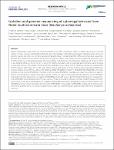Isolation and genome sequencing of cytomegaloviruses from Natal multimammate mice (Mastomys natalensis)
| dc.contributor.author | Hansen, F | |
| dc.contributor.author | Vučak, M | |
| dc.contributor.author | Nichols, J | |
| dc.contributor.author | Hughes, J | |
| dc.contributor.author | Bane, S | |
| dc.contributor.author | Camiolo, S | |
| dc.contributor.author | da Silva Filipe, A | |
| dc.contributor.author | Ostermann, E | |
| dc.contributor.author | Staliunaite, L | |
| dc.contributor.author | Chan, B | |
| dc.contributor.author | Mauch, T | |
| dc.contributor.author | Sogoba, N | |
| dc.contributor.author | Streblow, DN | |
| dc.contributor.author | Voigt, S | |
| dc.contributor.author | Oestereich, L | |
| dc.contributor.author | Ehlers, B | |
| dc.contributor.author | Redwood, AJ | |
| dc.contributor.author | Feldmann, H | |
| dc.contributor.author | Brune, W | |
| dc.contributor.author | Rosenke, K | |
| dc.contributor.author | Jarvis, MA | |
| dc.contributor.author | Davison, AJ | |
| dc.date.accessioned | 2023-11-02T15:17:06Z | |
| dc.date.available | 2023-11-02T15:17:06Z | |
| dc.date.issued | 2023-08-29 | |
| dc.identifier.issn | 0022-1317 | |
| dc.identifier.issn | 1465-2099 | |
| dc.identifier.other | ARTN 001873 | |
| dc.identifier.uri | https://pearl.plymouth.ac.uk/handle/10026.1/21558 | |
| dc.description.abstract |
<jats:p>Distinct cytomegaloviruses (CMVs) are widely distributed across their mammalian hosts in a highly host species-restricted pattern. To date, evidence demonstrating this has been limited largely to PCR-based approaches targeting small, conserved genomic regions, and only a few complete genomes of isolated viruses representing distinct CMV species have been sequenced. We have now combined direct isolation of infectious viruses from tissues with complete genome sequencing to provide a view of CMV diversity in a wild animal population. We targeted Natal multimammate mice (<jats:italic>Mastomys natalensis</jats:italic>), which are common in sub-Saharan Africa, are known to carry a variety of zoonotic pathogens, and are regarded as the primary source of Lassa virus (LASV) spillover into humans. Using transformed epithelial cells prepared from <jats:italic>M. natalensis</jats:italic> kidneys, we isolated CMVs from the salivary gland tissue of 14 of 37 (36 %) animals from a field study site in Mali. Genome sequencing showed that these primary isolates represent three different <jats:italic>M. natalensis</jats:italic> CMVs (MnatCMVs: MnatCMV1, MnatCMV2 and MnatCMV3), with some animals carrying multiple MnatCMVs or multiple strains of a single MnatCMV presumably as a result of coinfection or superinfection. Including primary isolates and plaque-purified isolates, we sequenced and annotated the genomes of two MnatCMV1 strains (derived from sequencing 14 viruses), six MnatCMV2 strains (25 viruses) and ten MnatCMV3 strains (21 viruses), totalling 18 MnatCMV strains isolated as 60 infectious viruses. Phylogenetic analysis showed that these MnatCMVs group with other murid viruses in the genus <jats:italic>Muromegalovirus</jats:italic> (subfamily <jats:italic>Betaherpesvirinae</jats:italic>, family <jats:italic>Orthoherpesviridae</jats:italic>), and that MnatCMV1 and MnatCMV2 are more closely related to each other than to MnatCMV3. The availability of MnatCMV isolates and the characterization of their genomes will serve as the prelude to the generation of a MnatCMV-based vaccine to target LASV in the <jats:italic>M. natalensis</jats:italic> reservoir.</jats:p> | |
| dc.format.extent | 001873- | |
| dc.format.medium | ||
| dc.language | en | |
| dc.publisher | Microbiology Society | |
| dc.subject | cytomegalovirus | |
| dc.subject | genome sequence | |
| dc.subject | herpesvirus | |
| dc.subject | Mastomys natalensis | |
| dc.subject | Mastomys natalensis cytomegalovirus | |
| dc.subject | muromegalovirus | |
| dc.title | Isolation and genome sequencing of cytomegaloviruses from Natal multimammate mice (Mastomys natalensis) | |
| dc.type | journal-article | |
| dc.type | Article | |
| plymouth.author-url | https://www.ncbi.nlm.nih.gov/pubmed/37643006 | |
| plymouth.issue | 8 | |
| plymouth.volume | 104 | |
| plymouth.publication-status | Published | |
| plymouth.journal | Journal of General Virology | |
| dc.identifier.doi | 10.1099/jgv.0.001873 | |
| plymouth.organisational-group | |Plymouth | |
| plymouth.organisational-group | |Plymouth|Research Groups | |
| plymouth.organisational-group | |Plymouth|Faculty of Health | |
| plymouth.organisational-group | |Plymouth|Research Groups|Institute of Translational and Stratified Medicine (ITSMED) | |
| plymouth.organisational-group | |Plymouth|Research Groups|Institute of Translational and Stratified Medicine (ITSMED)|CBR | |
| plymouth.organisational-group | |Plymouth|REF 2021 Researchers by UoA | |
| plymouth.organisational-group | |Plymouth|Users by role | |
| plymouth.organisational-group | |Plymouth|Users by role|Academics | |
| plymouth.organisational-group | |Plymouth|REF 2021 Researchers by UoA|UoA01 Clinical Medicine | |
| plymouth.organisational-group | |Plymouth|Faculty of Health|School of Biomedical Sciences | |
| dc.publisher.place | England | |
| dcterms.dateAccepted | 2023-08-02 | |
| dc.date.updated | 2023-11-02T15:17:05Z | |
| dc.rights.embargodate | 2023-11-3 | |
| dc.identifier.eissn | 1465-2099 | |
| rioxxterms.versionofrecord | 10.1099/jgv.0.001873 |


